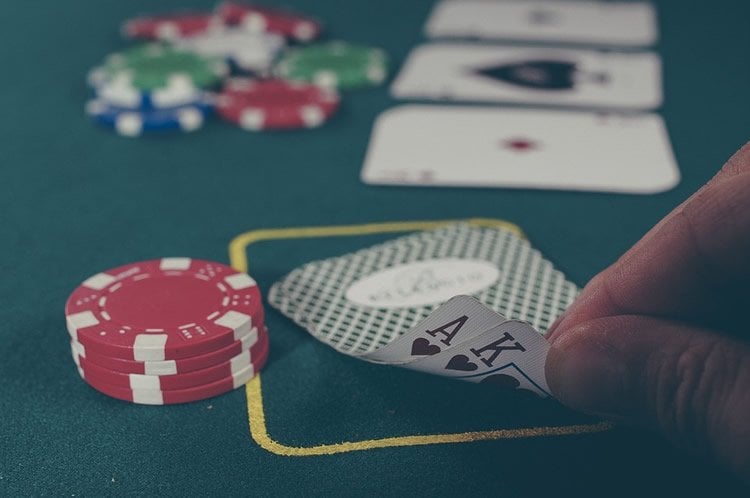Body Language At The Poker Table
If you decide to disconnect from virtual play for a while to play in alive setting, you need to think about how body language and physical appearanceare going to affect your performance. In a real-life setting, poker players tryto read other players by looking at the way they are dressed, the way they holdthemselves, and their facial expressions, so you need to be careful not to givethe wrong impression (unless you want to give them false tells, of course, butthat’s a risky strategy).
BODY LANGUAGE Quite a few players' posture betrays the nature of their cards. An unconscious change in their sitting position, such as leaning forward, likely indicates a strong hand. With a weak hand they often show less body tension, for example, having hanging shoulders. Body Language Is Also Subtle, and Poker Players Learn This When playing a game of cards, people may inadvertently express their confidence, or lack thereof, in the cards they have been dealt. It could be a frown that says, “I hate these cards.” It could be a sudden intense stare at other players that says, “I think I have a good hand.”. Poker Awareness: Timing Tells, Table Talk, & Body Language TD 7 years ago A lot of opponents give off information unconsciously that we can use to our advantage to exploit against them. #1528 - poker face: mastering body language to bluff & read tells. Studying Poker Tells Studying poker tells is effectively studying body language. One of the key principles of studying body language is you have to establish a baseline.
I’m not saying you have to wear a big cowboy hat like those guys in poker movies,but you will need to think carefully about how you dress and how you’representing yourself to the other players at the table.
What to wear
The number one tip would probably be this: don’t try too hard! If you showup at a live poker game wearing a tuxedo like a James Bond wannabe, people arenot going to take you seriously. This isn’t a movie! Lots of poker playersfavor clothes that cover their faces, such as hoodies, hats, and sunglasses, asthese can help to minimize visible physical tells. But, conversely, they canalso draw attention to you, perhaps mark you out as someone who lacks theexperience to control their physical tells and might, in specificcontexts, be perceived as a sign of weakness.
Body Language At The Poker Table
Another potential downside to covering your face with hoods and glasses isthat you may be preventing yourself from using your facial expressions to givefalse tells. As we mentioned earlier, this can be a risky strategy, but ifyou’re an experienced live-action player and confident in your ability tomanipulate your opponents’ thinking with false physical tells, then ditch thesunglasses and hoodies.
You need to think carefully about all of these variables, where you’replaying, who you’re playing with, and what you feel comfortable wearing whenplanning your outfit for a live poker game. As it’s essential to stay relaxedand calm during a poker session, choosing clothes that you feel mostcomfortable in is probably the best approach.
Body language

Reading Body Language At The Poker Table
The other factor in this equation is body language beyond the facial expressions mentioned above. It’s common to hear statements such as “80% of all communication is non-verbal,” and, while there is some debate on the exact figures, what is doubtlessly true is that non-verbal communication, i.e., body language, is incredibly important, especially in the context of a live-action poker game.
Strong = weak
A very general rule to follow is this: strong body language means the playerhas a weak hand, and weak or disinterested body language means the player has astrong hand. For instance, if a player puts on a brash and confident air whenmaking bets by raising their voice, slamming chips about, and being veryemphatic in their movements, then they may well be trying to overcompensate forweak cards. If, on the other hand, a player sighs dejectedly, folds their arms,and leans back from the table during play, they may well be sitting on a greathand.
These are very general rules of thumb, of course, and you’ll also need toobserve other player’s behavior over time, looking for patterns and trying toconstruct some frame of reference. Try and gauge what their normal behavior isand watch out for deviations from it, then you will start to get a moredefinite sense of how to interpret their body language.
For example: what is their regular breathing pattern? Can you notice theirbreath becoming heavier or shallower? Do they like to maintain eye contact, ordo they prefer to look away? Is their general body language open, or closed?When you have established some reference points, you will notice when theirbehavior deviates from this norm, which may well indicate that the player isholding some good cards. Be observant of and responsive to changes in youropponents’ body language, and you could find yourself improving your game.
In short, poker is a complicated game, and successful players have to beable to process large amounts of information from several channels to win. Youropponents’ physical appearance is one of those channels. Tune in to it.
21:1420 Jul
Every poker player gets dealt the same hands over time. Every hole combination has a certain percentage chance of winning against any other hole cards so it is how you play the hands rather than whether you or not you are dealt them that determines your success.
Presuming each hand wins the same number of times without any “moves” we can instantly see that winning pots with our weak hands will make us more successful. The process of doing so is known as bluffing. Bluffing is the art of winning a potby forcing the opponent to fold even though you hold such a weak hand it would not even stand up to a crying call. It’s a great feeling to successfully execute a bluff, especially against a good player.
Whether you can successfully execute a bluff depends on many factors. Your body language is just one of a number of things that must align in order for your bluff to work, and in this article we are going to look at some ways you can ensure you do not blow your bluff because of bad body language.
With over 55% of all communication being non-verbal, you ignore the signals your body gives out at your poker peril.
Don’t Oversell
Poker players generally do not flail around like lunatics openly displaying emotion. If you behave like this out of the blue, it will appear more than a little suspicious. When I talk about body language as I explain the concepts in this article, please note I mean in it’s most subtle form. You want your opponents to think they have spotted something that they think you believe is hidden, so thrashing around in a crazed fashion will not convince your opponents you are unaware of your actions!
Conscious Consistency
It is amazing how much information can be gained at the poker table without a word ever being uttered. It sometimes seems to me that because we are tuned into subtle body language signals anything obvious hits us like a ton of bricks!
You must make a conscious effort to be consistent, regardless of whether your hand is weak or strong. It can be tempting to get excited after a spell without a hand when you suddenly look down at pocket aces or pocket kings in the same way it can be easy to react with a slump of the shoulders when you look down at 7 2 offsuit for what seems like the hundredth time in the tournament you have been dealt it.
When you decide to bluff and your body language is consistent, you are giving no free information away. Your opponent will be looking for clues in your betting patterns as your story must check out, however, they will be looking for other clues too so you are protecting your hand if you remain in control of your emotions.
Deliberate Deception
After you have mastered emotional control you can begin utilize deception and acting to improve your chances of executing a successful bluff. In a marginal spot where your opponent is unsure whether to call or fold you can complete the bluff by nudging them over the edge with a subtle but effective physical gesture.
When you bluff you must show strength. You must never appear weak as this encourages your opponent to take a chance and call. However, if you overdo it to make sure your opponent notices your oscar-winning acting this can have the opposite effect and make you look really weak. This is the last thing you want because it increases the likelihood of your opponent calling and if you are bluffing your hand sucks!
Trying too hard to appear normal is known as the calling reflex. The ‘calling reflex’ is a term associated with amateur players who will go to incredible lengths to appear ‘normal’ (I do this in everyday life!) and thus they appear “different”. You can dramatically improve your bluffs by learning to look calm convincingly. This is a deception in itself.
Set up a ‘False Tell’
You can do various things to set up a false signal in your body language which might “tip off” your opponent that you are strong. For example, if you have an Ace in your hand and you catch an ace on the turn, check your hole cards every time you hit the ace. Hopefully it happens often enough where your opponent notices this apparent quirk in your game. They might link your checking of your hand if you hit with strength.
This is just one example and there are tons of other false tells you can develop over time. Make sure your opponent is capable of noticing these moves, otherwise you are wasting your time.
Use Amateur Presumptions against your opponent

There are a number of “rookie moves” associated with bad play that your opponents may see you doing and think they have just gained an edge when in reality they have just fallen into your trap. One such move is looking at your cards and quickly betting. This looks like an honest move and your opponents will believe you. Another “newbie” move is to casually take a sip of your drink after betting. Amateurs do this to look calm and in control, probably because they are panicking and hiding their excitement. If your opponent has read his “obvious bluffs by amateurs” tips, this action will look strong. Other examples of talking or staying quiet (whichever is not the norm for you) or placing your hand over your mouth, a subtle body language move where the body hopes to conceal emotion.
It is worth noting that these moves will only work if your opponents don’t know you and could therefore believe you completely suck at poker. For some reason no-one has ever questioned me when I bust one of these moves. I am sure this is a co-incidence!